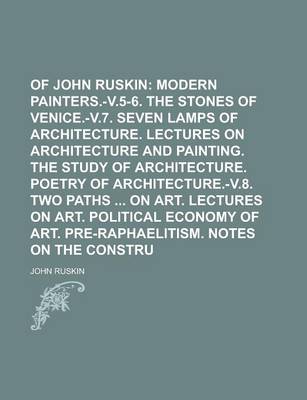Cambridge Library Collection - Works of John Ruskin
34 primary works • 44 total works
Volume 1
Volume 2
Volume 3
Volume 4
Volume 5
Volume 6
Volume 7
Volume 8
The Works of John Ruskin: Volume 8, The Seven Lamps of Architecture
by John Ruskin
Volume 9
The Works of John Ruskin: Volume 9, The Stones of Venice I
by John Ruskin
Volume 10
The Works of John Ruskin: Volume 10, The Stones of Venice II
by John Ruskin
Volume 11
The Works of John Ruskin: Volume 11, The Stones of Venice III
by John Ruskin
Volume 12
The Works of John Ruskin: Volume 12, Lectures on Architecture and Painting
by John Ruskin
Volume 13
The Works of John Ruskin: Volume 13, Turner; the Harbours of England
by John Ruskin
Volume 14
Volume 15
The Works of John Ruskin: Volume 15, The Elements of Drawing and The Laws of Fesole
by John Ruskin
Volume 16
The Works of John Ruskin: Volume 16, 'A Joy For Ever' and The Two Paths
by John Ruskin
Volume 17
The Works of John Ruskin: Volume 17, Unto This Last; Munera Pulveris; Time and Tide
by John Ruskin
Volume 19
Volume 20
Volume 21

